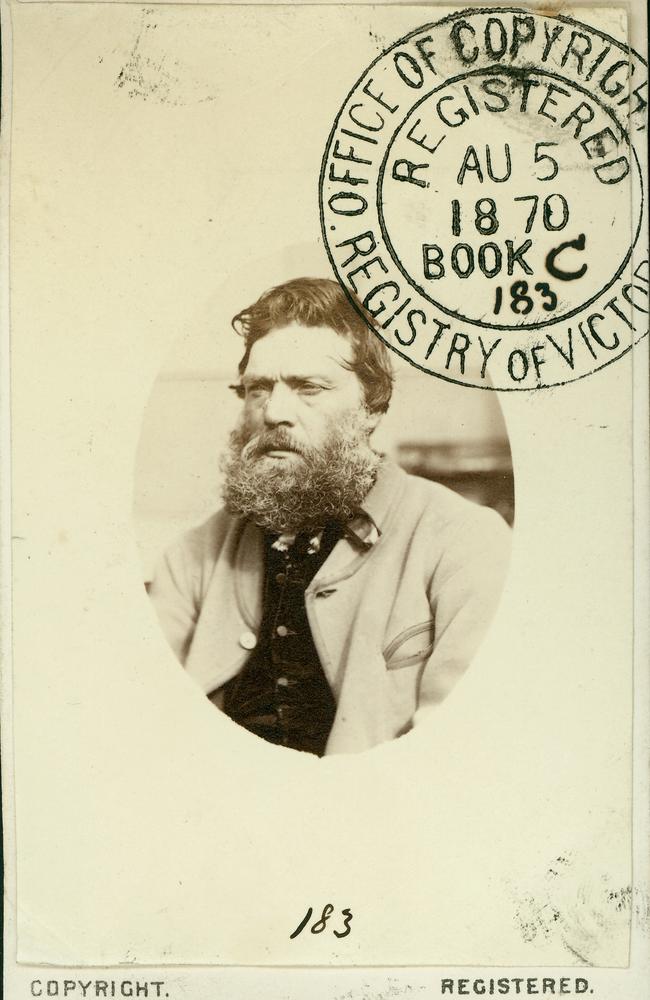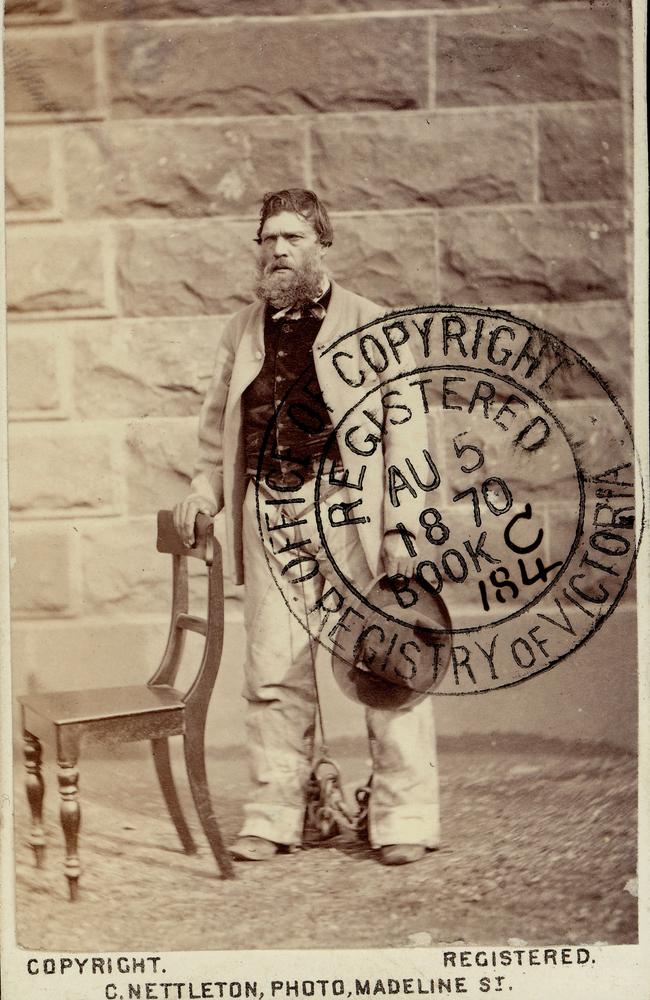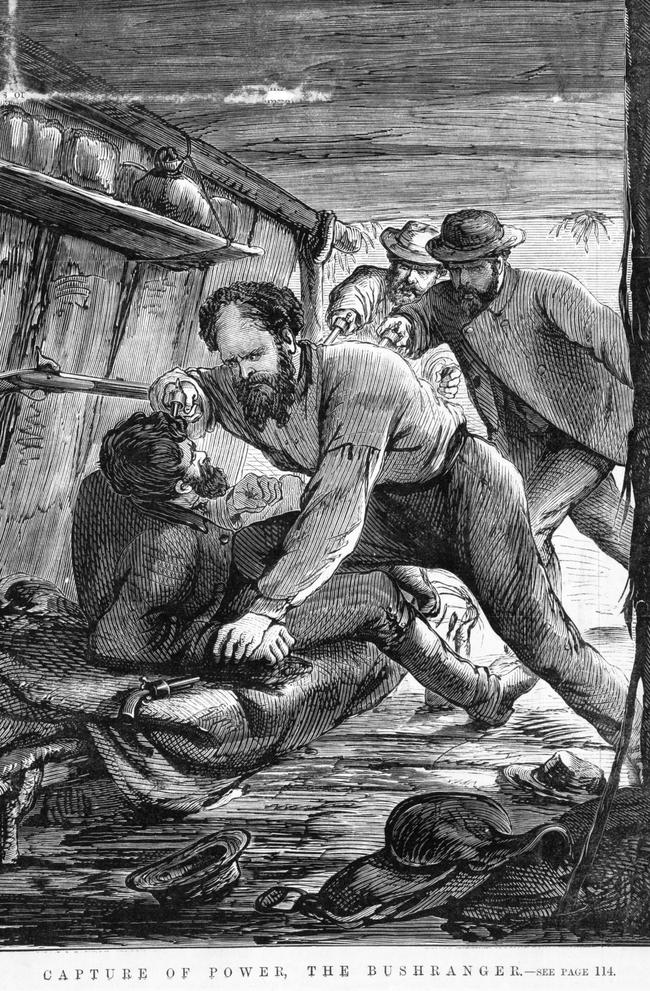Harry Power: Anniversary of the death of Ned Kelly’s mentor
Ned Kelly was just a teenager when he heard of a happy-go-lucky Pom called Harry — whose infamous crimes planted a dangerous seed in his mind.
When Ned Kelly was still a teenager, Harry Power was a household name in Australia — for all the wrong reasons.
In one year, he carried out 600 robberies, holding up travellers on the coach road from Mansfield, Victoria, to Jamieson, a small town at the junction of the Goulburn River and Jamieson River, terrorising men and charming the ladies.
What set Power apart from other bushrangers was that he was, apparently, a gentleman. He was very rarely violent and never killed his victims, nor the police that hunted him down.
Word got around that he was a pleasant chap, with local ladies telling police that he’d flatter them, telling them they were beautiful, even as he was robbing them.
Harry Power entered the world as Henry Johnson, born in 1820 in Waterford, Ireland, living in Lancashire, England, for much of his childhood. At the age of 16, Power was an apprentice in the saddler trade but threw that away to join the Peasants’ Revolt against the British troops where it’s said he received the distinctive scars across his face.
Victorian police records describe Power’s appearance as “scar over right eyebrow, scars on right cheek”.

His troubles began in 1840 when he was sentenced to seven years in prison for stealing — one report claims he stole a pair of shoes, while another states he stole a saddle. Whatever he really stole, the sentence was incredibly harsh and Power was transported to Tasmania, arriving in Hobart in 1842.
But, thanks to good behaviour, Power was lucky enough to be granted a ticket-of-leave after five years. Then, when he got his Certificate of Freedom a year later, he made his way to Victoria, attracted by the lure of the gold diggings.
When he failed to find gold at the Ballarat diggings, he tried his hand at being a horse dealer but ran foul of the law in 1855 when he was spotted in the Maryborough district riding a valuable horse that witnesses suspected was stolen. When Power was challenged by a couple of police officers, an argument broke out, leaving one of the men wounded.
According to the Gippsland Times, which published an interview with Power many years after the event, in April 1877, Power claimed he was innocent. He was riding his own horse.
In Power’s words, this is how the altercation unfolded:
“I was going along quietly, when down came the two troopers, hooting and shouting. I saw they were drunk, and pulled on one side, but they stopped me.
“‘Whose horse is that’?” says one.
“‘It’s mine’,” says I.
“‘I believe you stole that horse’,” says the first.
“‘You’re a liar’,” says I.
“You’ll have to come along with us’,” says the other.
“‘I won’t do it’,” says I, getting riled.
“On that one of them drew his hanger. He charged at me, and I’d only just time to draw my revolver, or he’d have cut me down. I shot him, and then the other fellow rode up and fired at me, and the powder singed my coat. I shot him, and then rode off.”
Power fled to the bush but was captured days later while attempting to cross the Murray River. In September 1855, he was sentenced to 14 years in prison for “wounding with intent to do bodily harm”.
He spent the first two years on the prison ship Success where he was implicated, along with others, in the murder of Owen Owens and John Turner on October 22, 1856, but was found not guilty. After two years and a half in the hulks, he was transferred to Pentridge stockade, an Australian prison that was first established in 1851 in Coburg, Victoria.
He was released after serving six years but jailed again in 1864 for horse stealing — but this time he managed to escape from Pentridge in the prison rubbish cart.
It was this new “life on the run” that propelled Power into local folklore as a bushranger.
Knowing it was impossible to make a living as a fugitive, Power held up hundreds of coaches from his base in the Ovens and Beechworth area. He targeted every coach, from private to mail coaches, as well as anybody unlucky enough to cross his path.
Yet Power quickly grew a reputation for the fine sense of humour he displayed when he carried out his robberies, as well as the fact that he didn’t kill any of his victims.
One story goes that Power was confronted by three armed men who told him they were hunting the bushranger Power. He admitted that he was Power and begged them for
protection, pretending to go along with them. But, he quickly turned on them, robbing them of their guns and clothing, leaving them in the bush so they’d have to make their way home — completely naked.

Overall, Power liked to work alone. But at one stage a young Ned Kelly was said to have worked as his accomplice. He’d made friends with Kelly’s extended family, the Quinns, and many believe that as a young boy Kelly learnt the tricks of the bushranger trade from Power.
Aged 16, Kelly was arrested at Greta in May 1870 and charged with having assisted Power in a robbery, but he was discharged for lack of evidence. Several reports claim that Kelly had ridden with Power — who later said that after several shots were fired in a chase by troopers, Kelly had wanted to surrender.
The media at the time blamed Power for corrupting the young Kelly
“The effect of his example has already been to draw one young fellow into the open vortex of crime and unless his career is speedily cut short, young Kelly will blossom into a declared enemy of society,” wrote The Benalla Ensig in 1870.
While plenty of people wanted Power dead, he had enough sympathisers to keep him going, particularly those in the district who aided and protected Power. But not everyone sympathised with bushrangers.
On May 31, 1871, a Mr Robinson from Mansfield wrote to the Chief Secretary that, “a large number of respectable inhabitants of this district are willing to tender their services as special mounted constables for the purpose of assisting the police to the capture of Power and his associates who have long infested and disturbed this district”.
In mounting frustration, police offered a £500 reward for his capture — a huge amount of money for those days.
At this stage, Power was described as “probably English, aged 40 or 50, 5 ft6 or 7 with short greyish beard and heavy eyebrows, wearing a light grey sac-coat of raised pattern, light trousers, a light brown felt hat and blucher boots”. (Note: a blucher boot was characterised by its open lacing. The style was named in honour of the Prussian field marshal Gebhard Blücher.)

A search party set out, led by aboriginal tracker “Donald”, two police officers and a horseback procession of civilians, most of whom were probably just wanting a piece of the action.
James Quinn, Ned Kelly’s grandfather, led police to Power’s hide-out because he was hoping to claim the reward. Power was found hiding out in a comfortable gunyah (bark shelter) on the Quinn’s Glenmore property. The constables who arrested Power rejected the reward — Donald was given £10, while James Quinn pocketed the £500 reward.
At the age of 50, Power was sentenced to 15 years hard labour on three counts of bushranging and sent back to Pentridge, which was said to be an “absolute hell hole” but was likely as hellish as any prison in those days.
By 1877 Power’s health was going downhill, but he had plenty of “fans” in Melbourne; including Lady Janet Clark, who heard about his declining health and petitioned for his release.
Once Lady Clark helped secure Power’s freedom, she gave him a job that saw him living the next decade in peace, working on her property as a gardener. But, by 1891, Power had landed himself a job as a guide to the Success, where he had once been imprisoned.
The Success was turned into a macabre travelling waxwork display of the torture and punishment dealt out to criminals.

Sadly, Power’s new career didn’t last very long — in November 1891 he drowned after falling into the Murray River.
Power died, aged 72, with nothing but a few shillings to his name. But what a name it was. Whether people approve of the “glorification” of Aussie bushrangers or not, it’s a name that has never been forgotten.
Beyond his crimes, the dark years behind bars, prison escapes, years of bushranging and life as a fugitive, few could disagree that Power was the least violent of his day, always holding true to his unique code of honour.
Plus, the other legacy he left behind; that of a fine and daring horseman. There’s a lookout in Whitfield, Victoria named “Power’s Lookout” in honour of the man who went down in history as, not only the mentor of Ned Kelly, but the “Gentleman Bushranger”.
— LJ Charleston is a freelance journalist. Follow her on Twitter @LJCharleston



